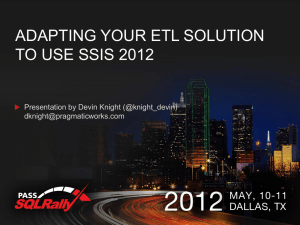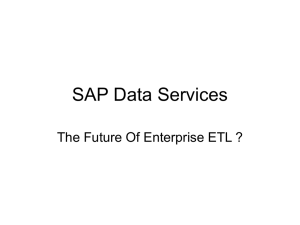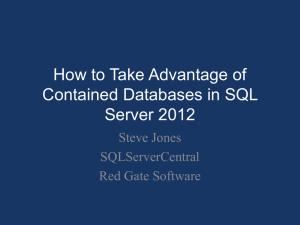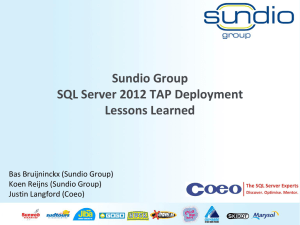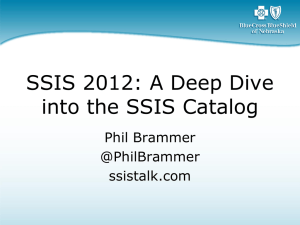BI-User-Group-SSIS
advertisement
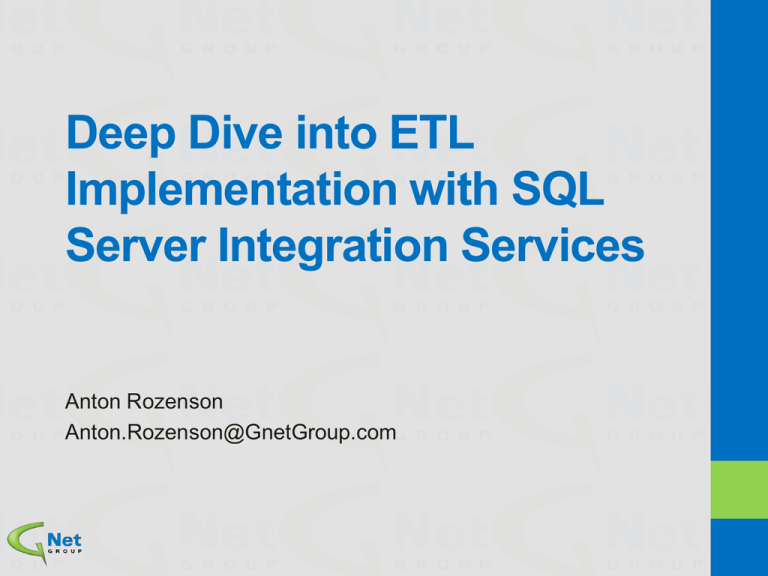
Deep Dive into ETL Implementation with SQL Server Integration Services Anton Rozenson Anton.Rozenson@GnetGroup.com About this training event • First event with core focus on Microsoft BI technology • Help the community by sharing our learning and experience based on real world scenarios • Network with peers and learn from you! • These training events will be held every 2 months Agenda • Importance and complexity of ETL process • ETL Architecture • Changed Data Capture challenge and options • Data Flow design and performance considerations • SSIS project deployment • Package execution options • Performance monitoring in SSIS catalog Moving data • “Data Warehouse is a system that extracts, cleans, conforms, and delivers source data into a dimensional data store and then supports and implements querying and analysis for the purpose of decision making” – Ralph Kimball, Joe Casertam. (2004) “The Data Warehouse ETL Toolkit • Estimated 80% of work in building Data warehouse solution is related to ETL design and implementation • Data Warehouse is only as good as the data that it contains Common ETL Architecture Sources Staging EDW Flat File Data warehouse RDBMS Cloud • Changed data • Reference data • Artifacts and Error tables • Consumption ready • De-normalized • Clean data ELT Architecture Sources EDW Flat File Data warehouse RDBMS Cloud • Changed data • Reference data • Artifacts and Error tables • De-normalized • Retains traceable business key CDC Challenge What Changed? When changed ? Unable to modify source systems to include CDC attribution? Reliable timestamps? Need to reliably determine modified data for incremental loading New data Updated data Deleted data CDC options Source system can provide time stamps • Reliability of process and completeness of information? • Did all yesterday’s transactions committed? • Does Source system include work flows that can cause late arrival of data records? • How to determine deleted records? Comparing EDW data to Source system to determine differences • Very expensive query affecting Source system • Does Source System incorporates archival process? Operational Data Store (ODS) can help • Keeping change history • Clearly define state of data records • Stores metadata CDC in SQL 2014 In SQL Server, change data capture offers an effective solution to the challenge of efficiently performing incremental loads from source tables to data marts and data warehouses. Change Data Capture process stores transaction information from SQL log into system tables in CDC Schema. Data from CDC tables can be extracted by using table valued functions generated when CDC is enabled on the table. Key concepts: • LSN – a binary timestamp representation used to restrict changed set • All Changes – changed set includes all DML transactions • Net Changes – changed set includes last DML transactions based on unique index. Demo Data Flow design challenges How should Data Flow perform? Consider following factors when designing an ETL Solution • Source System structure and ability to execute logic such as sorting and filtering. • Parallel processing should be used with caution. Fastest way to load a table is Fast Load with table lock. This prevents loading data in parallel. Partition switching can be an answer. • Requirements for data availability in EDW • Service Level Agreement (SLA) Data Flow blocking tasks Data flow transformations in SSIS use memory/buffers in different ways. The way a transformation uses memory can dramatically impact the performance of your package. Transformation buffer usage can be classified into 3 categories: Non Blocking, Partially Blocking, and (Full) Blocking. Non Blocking transformations: Audit, Character Map, Conditional Split, Copy Column, Data Conversion, Derived Column, Import Column, Lookup, Multicast, Percentage sampling, Row count, Row sampling, Script component Partially Blocking transformations: Data mining, Merge, Merge Join, Pivot/Unpivot, Term Extraction, Term Lookup, Union All Blocking transformations: Aggregate, Fuzzy Grouping, Fuzzy Lookup, Sort Work around blocking transformations in Data Flow It is not always possible to avoid using blocking or partially blocking transformations, but in some cases it is possible. For example Merge transformation requires data set to be sorted. While Sort transformation is expensive, in some cases sorting can be handled in the source query. Make sure to set IsSorted property of Data Source output to true and assign proper SortKeyPosition to output columns. Another example is Aggregate Transformation. Use Script transformation to perform aggregation of data and return result to a variable. Demo Project Deployment model Project deployment model allows following features: • Parameters can be used in expressions or tasks. Parameters can reference an environment variable. Environment variable values are resolved at the time of package execution. • An environment is a container of variables that can be referenced by Integration Services projects. Environments allow you to organize the values that you assign to a package. For example, you might have environments named "Dev", "test", and "Production". • SSISDB catalog allows you to use folders to organize your projects and environments. • Catalog stored procedures and views can be used to manage Integration Services objects in the catalog. Package Execution An execution is an instance of a package execution. Package execution can be scheduled via SQL Agent job. SQL Agent provides an easy to use interface for mapping of Project parameters to environment variables. Packages can also be executed via Execute package tasks from another SSIS package. This allows creation of robust workflow incorporated into the Master Package. Package Execution SSIS catalog allows package execution to be controlled programmatically from within T-SQL. A Number of stored procedures are provided to manage Package Execution. catalog.create_execution creates an instance of package execution and assigns Execution_ID. catalog.set_execution_parameter_value assigns parameters to the instance of package execution. Execution parameters control Logging Level, Dump settings, Synchronized execution option as well as ability to assign values to Project or Package scoped parameters. catalog.start_execution starts an instance of execution. Execution Monitoring Catalog provides a set of standard reports allowing administrators easy access to execution performance and statistics. For details about executions, validations, messages that are logged during operations, and contextual information related to errors, query these views. executions list of Executions includes environmental data execution_data_statistics data flow performance information execution_parameter_values list of run time parameters event_messages messages that were logged during executions Demo Questions Additional Resources What's New in SQL Server 2014 http://msdn.microsoft.com/en-us/library/bb500435.aspx SSIS Catalog http://msdn.microsoft.com/en-us/library/hh479588.aspx Deployment of Projects and Packages http://msdn.microsoft.com/en-us/library/hh213290(v=sql.120).aspx Change Data Capture http://technet.microsoft.com/en-us/library/bb522489(v=sql.105).aspx Change Data Capture (SSIS) http://msdn.microsoft.com/en-us/library/bb895315.aspx CDC Flow Components http://msdn.microsoft.com/en-us/library/hh231087(v=sql.120).aspx Enable and Disable Change Data Capture (SQL Server) http://msdn.microsoft.com/en-us/library/cc627369.aspx SQL Server OLE DB Deprecation and Integration Services http://blogs.msdn.com/b/mattm/archive/2012/01/09/sql-server-ole-db-deprecation-and-integration-services.aspx oData Data source setup http://www.microsoft.com/en-us/download/details.aspx?id=42280 oData samples http://services.odata.org/ Contact Us www.gnetgroup.com Neelesh Raheja VP, Consulting Services Anton Rozenson BI Solution Architect Neelesh.Raheja@gnetgroup.com Anton.Rozenson@gnetgroup.com @PracticalBI blog.gnetgroup.com facebook.com/gnetgroup linkedin.com/company/143712 youtube.com/user/GNetGroup twitter.com/GnetGroup


